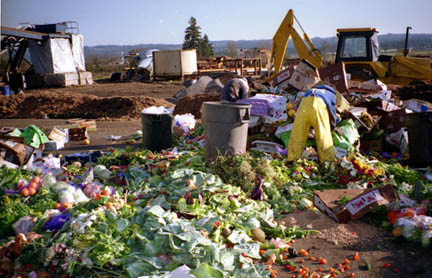Coalition for Waste
Alternatives ponders options
by
Karin Grobe
What will you do with
your garbage when all the local landfills are closed? Burn it? Ship
it somewhere else? Bury it in your backyard? Santa Cruz County residents
have demonstrated strong opposition to siting any new landfills
in the county. The Buena Vista landfill will be full in 15 years,
and it's just a matter of time until the landfills run by the cities
of Santa Cruz and Watsonville fill up. What do we do after that?
 |
|
Workers check food scraps for contaminants
such as plastic bags at this compost site near Portland, OR.
Photo - Karin Grobe
|
Santa Cruz County residents
interested in promoting environmental solutions to the garbage problem
have formed the Coalition for Waste Alternatives. The group's mission
is to help shape the long-term waste management strategy of Santa
Cruz County by:
o Influencing the Santa
Cruz County Integrated Waste Management Local Task Force to implement
the most environmentally and socially responsible long-range waste
management program possible;
o Lobbying elected officials
in support of new diversion programs and full implementation of
existing programs;
o Promoting new aggressive
waste diversion alternatives and incentives.
The Santa Cruz County
Integrated Waste Management Local Task Force has advanced a number
of waste-cutting measures, among them a Zero Waste resolution, mandatory
recycling, mandatory trash collection in the urban area and a 10-gallon
garbage can option. The Coalition will be weighing in on these measures
which could help tremendously in extending the life of the county
landfill. Opposition to mandatory recycling may come from businesses
and apartment managers who don't want to sort their garbage.
According to the 1999
county waste sort, food waste accounts for 30% of the material in
residential garbage carts. Food waste at restaurants is about 65%
of refuse and ranges from 25-40% in agricultural, retail food, finance/real
estate and other service-oriented businesses. The county would like
to provide for food waste collection at all businesses and residences.
Programs for food scrap collection and composting have been successful
in reducing waste in San Francisco and East Bay cities, and the
resulting compost has been approved for use on organic farms. A
compost facility would require 20 or more acres. It could stand
alone or be coupled with other waste-handling facilities. Sensitivity
and hard work will be needed to identify space suitable for composting.
An updated waste composition
analysis is slated to occur next year. When the results are known
(probably at the end of 2006), the County will learn if the types
of garbage have changed since 1999 and what steps might most effectively
reduce waste even more.
Until Zero Waste is achieved,
there will be some garbage to deal with. Ideas on the table include
waste export, waste-to-energy, anaerobic digestion, pyrolysis, gasification,
and production of refuse-derived fuels. All of these options have
environmental consequences. Gathering information on these processes
from sources other than those selling the technology is critical
to making an informed decision.
If you wish to receive
email updates and alerts regarding solid waste, contact Karin Grobe,
427-3452, kgrobe@pacbell.net.
< back to all issues
|

